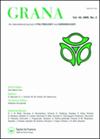57.Gregos Range(西班牙中部)奶酪之泉
IF 1
4区 生物学
Q4 PLANT SCIENCES
引用次数: 0
摘要
奎塞拉斯沼泽地(北纬40°16′59.82′′,西经4°55′15.28′′;面积约0.054公顷;海拔1295米[a.s.l])位于格雷多斯山脉东部的“Cabeza Aguda山脉”东南坡(佩德罗·贝尔纳多,阿维拉)。该地区属于地中海气候,夏季干燥温暖,冬季多雨,受来自西部的大西洋风影响。年平均气温14°C,年降水量1400毫米。该地区最具代表性的植物群落是海松(Pinus pinaster Ait.)林地和孤立的黑松Arnold亚种。salzmannii(Dunal)Franco和樟子松(López-Sáez等人,2019)。最上面的地区(1600–2008 m a.s.l.)被Cytisus oromediteraneus Rivas Martínez、Díaz、Prieto、Loidi&Penas和Echinostatum barnadesii(Graells)Rothm的扫帚群落占据。(LópezSáez等人,2016)。河岸林的特点是黑赤杨(Alnus glutinosa[L.]Gaertn.)和狭叶Fraxinus angustifolia Vahl。沼泽植被主要由Sphagnum sp.、Carex nigra(L.)Reich组成。基岩为以晚海西期花岗岩为主的老硅质基底。本文章由计算机程序翻译,如有差异,请以英文原文为准。
57. Manantial de las Queseras, Gregos Range (central Spain)
The Manantial de las Queseras mire (40o 16′ 59.82′′ N, 4o 55ʹ 15.28′′ W; size c. 0.054 ha; 1295 m above sea level [a.s.l.]) lies on the southeastern slope of the ‘Sierra de Cabeza Aguda’ in the eastern part of the Gredos Range (Pedro Bernardo, Ávila). The area experiences a Mediterranean climate with dry and warm summers and rainy winter months, influenced by the Atlantic winds from the west. The average annual temperature is 14 °C and the annual precipitation is 1400 mm. The most representative plant communities of the area are maritime pine (Pinus pinaster Ait.) woodlands, and isolated Pinus nigra Arnold subsp. salzmannii (Dunal) Franco and Pinus sylvestris L. trees (López-Sáez et al. 2019). The uppermost areas (1600–2008 m a.s.l.) are occupied by broom communities of Cytisus oromediterraneus Rivas-Martínez, Díaz, Prieto, Loidi & Penas and Echinospartum barnadesii (Graells) Rothm. (LópezSáez et al. 2016). Riparian forests are characterised by black alder (Alnus glutinosa [L.] Gaertn.) and Fraxinus angustifolia Vahl. The mire vegetation is composed mainly of Sphagnum sp., Carex nigra (L.) Reich. and Drosera rotundifolia L. The bedrock is old siliceous basement made up mainly of LateHercynian granites.
求助全文
通过发布文献求助,成功后即可免费获取论文全文。
去求助
来源期刊

Grana
生物-植物科学
CiteScore
2.10
自引率
11.10%
发文量
23
审稿时长
>12 weeks
期刊介绍:
Grana is an international journal of palynology and aerobiology. It is published under the auspices of the Scandinavian Palynological Collegium (CPS) in affiliation with the International Association for Aerobiology (IAA). Grana publishes original papers, mainly on ontogony (morphology, and ultrastructure of pollen grains and spores of Eucaryota and their importance for plant taxonomy, ecology, phytogeography, paleobotany, etc.) and aerobiology. All submitted manuscripts are subject to initial appraisal by the Editors, and, if found suitable for further consideration, to peer review by independent, anonymous expert referees. All peer review is single blind and submission is online via ScholarOne Manuscripts.
 求助内容:
求助内容: 应助结果提醒方式:
应助结果提醒方式:


